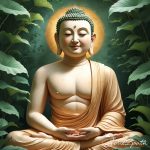The name Buddha conjures a vision of peace, mindfulness, and profound wisdom. To Sir Edwin Arnold, he was the “Light of Asia”, while historian William Dalrymple aptly referred to him as India’s greatest cultural export. Born in 563 BCE in the ancient land of Bharat, Gautam Buddha’s influence has transcended millennia and borders, spreading across the Himalayas into Tibet and Mongolia, flowing eastward into China, Japan, and Korea, and reaching Southeast Asia and even the ancient West.
Buddhism holds the distinction of being the world’s first missionary faith—not driven by conquest or conversion through force, but by an unshakeable commitment to service, compassion, and understanding. At its heart lies the ideal of the Bodhisattva—one who forgoes personal liberation in order to ease the suffering of others.
Though many historians frame Buddhism as a rebellion against Vedic orthodoxy or caste divisions, the reality is more nuanced. Gautam Buddha was not opposed to learning from Brahmin sages; in fact, his first disciples were Brahmins. Dissatisfied with the rigid answers he received from traditional teachers, he set out to find truth on his own terms. His spiritual journey took shape amidst the Shramana movement—a tradition that had already begun questioning rituals like animal sacrifice and caste-based duty. Far from being fringe, these ideas were gaining traction even within the broader Vedic worldview.
What made Buddhism revolutionary wasn’t simply what it rejected—it was what it offered in return. While others debated whether reality was entirely material or entirely spiritual, Buddha charted a unique path. He offered a view of life as neither permanently physical nor metaphysically eternal, but as impermanent, interconnected, and ever-changing. In doing so, he avoided the trap of nihilism on one side and rigid dogma on the other.
This elegant synthesis found its practical expression in the Middle Way—a philosophy of balance and moderation that shunned extremes. It is this middle path that made Buddhism universally appealing. It resonated not just with monks and seekers, but also with everyday people navigating the challenges of ordinary life.
Another key to the religion’s remarkable spread was the Sangha—the community of monks, nuns, and lay followers. Buddha recognised that spiritual growth wasn’t a solo endeavour. Collective strength, or sangha shakti, became a foundational pillar. Through the Sangha, his teachings travelled across continents, offering a sense of shared purpose and structure to seekers around the world.
But perhaps what made Buddha truly ahead of his time was his clarity about the limits of dogma. He didn’t insist his words be followed blindly. He compared his teachings to a raft—useful for crossing a river, but unnecessary to carry once you’ve reached the other side. His teachings, rooted in impermanence (anitya), no-self (anatman), and momentariness (kshanikavada), left no room for eternal commandments or fixed identities.
In one of his most powerful moments, when asked who would guide the followers after his passing, Buddha simply replied: Appo Deepo Bhava—“Be your own light.”
At a time when ideologies are clashing, and religion is often used to justify violence and division, Buddha’s voice is a gentle but powerful reminder. It’s not rigid belief or inherited rituals that lead us to peace, but self-awareness, compassion, and the courage to walk our own path with wisdom and humility.
In today’s noisy, turbulent world, the Buddha doesn’t just offer a set of teachings—he offers a way of being. And in that quiet, grounded way, he continues to illuminate lives across the globe.

